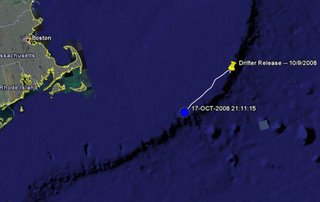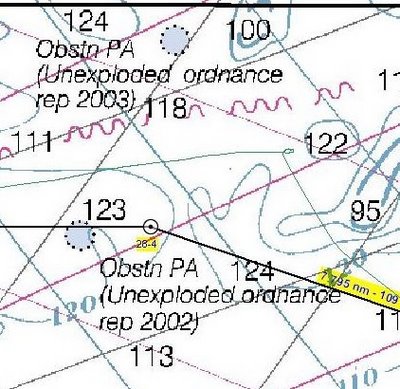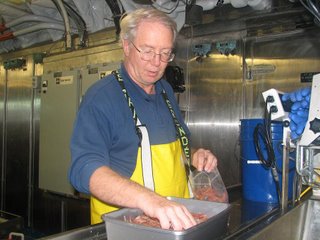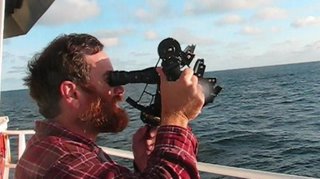
Saturday, October 18, 2008
Red Right Returning
Today as we returned to port, we sailed into Narragansett Bay with the red buoys on our right hand side. Red Right Returning. We pulled into port early in the morning.
Here is what the buoys look like on land!
I am very grateful to the CO, Commander Stephen Beckwith, the XO, Lieutenant Russell Haner, our Chief Scientists Phil Politis and the entire group of scientists and crew of the Henry B. Bigelow for their hospitality these last two weeks. Every person on board did everything they could to make this project a reality and to make this blog as valuable a resource as possible for the children who worked on it.
Thank you as well to Jennifer Hammond, Elizabeth McMahon of the Teacher At Sea Program, Commander Michael Gallagher in NOAA for support and for help with bandwidth issues, as well as Diane Stanitsky who made our Drifter Buoy happen.
Thank you as well to the SOCSD School Board, Administration, staff and students for their enthusiastic support for this project, and finally thank you to the SOCSD students and families who participated. It has been a pleasure working with you.
We made contact with our drifter buoy. Here is a map of where it has gone of far. It appears to be drifting south along the US coast. I can't wait to see what happens. We will have more data in the days and weeks to come. Check the drifter buoy link on this site to keep track of it.
the days and weeks to come. Check the drifter buoy link on this site to keep track of it.
This will be my last blog entry for this project.
--------------------
Now, final responses to comments and questions:
... And now the answer to the most frequently asked question of the entire trip: No, I did not get sick! Thanks be to good weather.
SP: Good question about the skate. I put the skate case back in the sea, and from there, I do not know what happened to it. Truth be told, most fish do not survive their first day. That is why most female fish lay many eggs many times during their life. Very few of the young ever become adults.
CM: Melting ice sheets and glaciers can (and has already) raise the sea level. Though it may raise it quite a bit, it will not flood the entire Earth. There is not enough water in the ice sheets for anything even close to that. But it will cause problems for areas near the coast that are low down. Climate change is also causing areas in the west of the USA to be a bit dryer and that has people worried about finding drinking water for some cities. Remember, you can't drink sea-water because of the salt. If it sounds confusing, think of it this way: Warm weather can cause deserts to grow and ice to melt. Thanks for your great question.
Is the water cold? Well, yesterday on my way home, I went swimming in the ocean on one of my favorite beaches in Rhode Island. It was not too cold, but it did wake me up.
The torpedo ray was about 4 feet long. I do not remember the weight, but it was very heavy.
NT: You are right, the shimp had eggs. Will the lobster be OK? Most of the lobsters we found on the ship went back into the sea and were just fine. They do quite well. We keep a few to analyze in the lab to see if we could solve the Shell Disease mystery.
HM: Were the fish interesting? Absolutely! Thanks for your kind words. I'll be back to school next week. See you then.
Are we having trouble finding fish in the ocean? No, but we do see changes. We did not find many cod near cape cod. We did find lots of fish that were not there many years before, like dogfish.
AR: Water pressure makes things smaller by squeezing on them from all sides. That's also what makes your ears pop when you swim in deep water.
SZ: I did not get stung by anything I touched.
LG: and many others: Zee and Snuggy are just fine. They are home too.
VP: I think octopus you saw were adults. That particular species of octopus does not get very large.
The shrimp were very small and did not weigh much. We weighed them in buckets together, so I don't know how much the individuals weighed. The cups start to shrink as soon as they hit water. The further down they go, the more they shink.
All the cups got small. I kept two on deck to show us how small they actually got.
I like to go to sea because I find it fun and because I like to learn.
B.B, the ray I was holding in one of the blog entries had an electrical charge if you touch it (I was wearing rubber gloves). That was the only dangerous creature.
J. I was not scared. I trusted the crew and scientists to know what I should and should not do.
P. I can't wait to show you that book as soon as it is done. Thanks for video conferencing with me.
Mrs. Christie Blick's Class. Yes, I will get you a water sample. I don't have a shell sample, but will try to get you one from Dr. Kunkel.
NW, they have a hospital that can handle many injuries. If the person is very badly hurt or sick, they would have to air-lift them to land.
MH: Wonderful comment. I enjoyed your thoughts. I have several baseball teams that I like, but while I was on the ship, I became a Red-Sox fan with all my New England friends for game 5 of the series. How exciting! Go Ortiz!
GH: I chose to go to sea. I love it. No one made me do it.
SQ: Good thought.
CP: Many species are affected by climate change. Many more than we probably realize.
I eat great things on the ship. They have excellent food.
Mrs. Christie Blick's Class: Dr. Kunkel has tested his shells in acid and is still working on finding out exactly what is going on. It may be that more than one factor are effecting lobsters.
MM: Coal helps create global warming when you burn it because carbon is released in the smoke.
JC: How long will global warming last? Even if we stop polluting now, it will take a long time to reverse the changes. The problem is we haven't stopped polluting, so the real answer is, no one knows. It depends on what we do now. Good question.
SP and TD: There are many things we can do to stop global warming and to help the ocean ecosystem. Let's talk about that in class when you come in. I have some video to show you about it.
KM: Because it is easier to say lets stop global warming, then to really do something about it.
KD: Carbon dioxide is a part of our ecosystem and it is important. Trees need it to breathe and without it in our air, the world would be too cold for us to live. We must have some carbon dioxide in our air. We just should not have so much of it. Think of it this way. They say that eating an apple a day keeps the doctor away, but eating 10 apples gives you a belly ache. Too much of even healthy things can cause problems.
AS: Good questions. No, we don't think that all the fish will die off, but change can be hard and it may cause a lot of damage to our earth if we continue what we are doing.
Mrs. Narciso's Class. Thanks for writing. Good thoughts.
Mrs. Beglin's Class: Great job. Thanks for writing.
MA are there huge spiders on the ship? No. There are no bugs that I saw.
JK and his mom: Thanks for your kind words and thanks for writing.
Thursday, October 16, 2008
A Visitor
A sea anemone. This opens up and tenticles appear. They wave their tenticles in the water to collect food. When fish like Nemo, the clown fish, go into a sea anomone, it will sting the fish, so the clown fish backs in which helps it tolerate the sting.

My title is fisheries biologist, but I am a specialist in the nets. My background is in trawl standardization. We have to ensure that our nets are constructed, maintained and that we fish same way each time. Small changes in nets can effect how the nets fish and that effects the study. That way we can compare this years catch to next years catch. Remember, this study is called a time series. Over time, you can see changes to fish population. The only way you can trust those numbers is if the nets are the same each time we put them in the water year after year, tow after tow. We have to document what we are doing now so that in the future, people know how and what we were doing. This way the time series remains standard. We have to standardize materials the nets are made of, way they are repaired. We inspect the nets each time we come on here. We train the deck crews in the maintenance and repair of our nets.
-------------------------------
In answer to many of your questions, I will be back to SOCSD on Monday. I'll be in WOS on Monday and CLE on Tuesday. See you then.
Mrs. Christie-Blick's Class:
You asked some AMAZING questions. I'm so proud of you guys. Drl Kunkel was impressed as well. Here is what He told me:
You asked: What is your proof that these lobster shells are softer than other lobster shells? How do you measure hardness:
We have an engineering department at U Mass and one of the projects they have to do to become materials engineers is to test for hardness and they do an indentation test. Another way is to shoot x rays at shell and we can tell how hard it is by how the x rays scatter.
You asked: What is causing the harmful bacteria in the water?
We don't know if they are harmful bacteria. My theory is that it could be the same normal bacteria that are on the backs of healthy lobsters. We think it is the weakness in the new lobster shells because of environmental influences south of Cape Cod that causes the trouble.
You asked: Can you get rid of the harmful bacteria?
It is possible to reverse the environmental conditions that have been created by us or by mother nature.
Hag fish did gross me out a little. Interestingly, there is no way to determine the age of this fish as there are with others, so I'm not sure we can even tell you how long they live.
Several of you asked about the red dots on the lobster. They are a disease. It is called shell disease.
SR, the water temperature is about 16 degrees C last time I checked.
MF, nice to meet you. It is really cool to be a Teacher At Sea.
DTR, my favorite thing about this trip is working with you guys from the middle of the ocean.
MR, Snuggy and Zee are having loads of fun touring the ship.
CF: I will try to count the teeth of a fish and tell you what I find. Sometimes they are hard to see. I do not know if I am going back next year, but I hope so. I like being at sea. The truth is, I like being on land too. Both are nice. Thanks for writing.
BS: No, we find mostly adults, but some babies. Many creatures are small as adults.
BV: We have seen lots of jellyfish. We had so many we had to hose down the lab at the end of our session the other day. They were everywhere.
GS: We will continue to take samples here.
TL and Many Others asked how long we put the cups down for: We put the cups down for about 15 minutes. That includes the time it takes to lower the CTD to the bottom. When it gets to the bottom, it comes right back up. Thanks all for writing.
AS: Right you are!
Good job calculating all those who got 984 feet!
MM, I love the adventures I'm having here and the people I am meeting. It has been fun. I like being on land too.
JS, Dr. Kunkel took samples from some lobsters so he could help cure the disease.
KF: Could the hag fish bit us? Yes, Mel Underwood, our Watch Chief was very careful as she held the bag and backed her hands up when the fish got close to her hands. Mel is very experienced working with sea life and I have never seen her back off the way she did with this thing.
HRF: Go for it! It is a cool job!
CF: Good question. No, your bones are a lot stronger than styrofoam, so you would have to go down many miles to hurt yourself, and you could not swim that far without gear. When divers get hurt from pressure changes, it is usually something different called the bends. This happens when you are swim up to fast and certain gases in your blood stream expand as the pressure increases and form bubbles that can hurt you. Divers have to swim up slowly (the usual rule is don't go up faster than the air bubbles next to you) in order to avoid getting the bends.
DC: Good questions: The dots are not bacteria on the lobster, they are the result of the bacteria eating away parts of the shell. The actual bacteria are too small to see. Good question about he temperature relating to growth. It is a bit more complex than that. There are many factors at work. The factor that may be causing more bacteria are chemicals like fertilizers from land getting into the water.
Dr. Kunkel came on board to study lobsters. He is a biologist, not a medical doctor. There are many scientists on board working with us, and me with them.
The quadrent is an old invention. People have been able to find their way with the stars for thousands of years. It is an ancient art. It was fun to practice it here.
SF, VF and others: The fish stayed in the bag. We made sure of that. From the bag, we put it back in the sea.
SD, sorry, I can't help you there. I don't think a pet skate would survive the trip back to NY.
Several of you have asked if I have gotten sick. No, I have not.
How many lobsters have we caught so far? Lots!
SS, sleeping on a boat if fun. If the waves are small, they rock you to sleep. If they are huge, however, they throw you out of bed!'
CP: bacteria infect the shells of the lobsters. This destroys the protection that the lobster should have. They grow weak and die of other causes. Good question!
Why do we work at night? Because ships work 24 hours a day so that no time is wasted. I ended up on the night shift. Why do we wear suits? To stay warm and dry on deck.
The hagfish eat shrimp and small fish, though they are scavengers and can eat large creatures as well.
Mrs. Christie Blick's Class, you guys are doing some great work. I check on the skates for you. Some skates have protection, like thorns or spikes. They also have some interesting fins that look almost like feet. They use these to “walk” along the bottom searching for food. I know you asked about skates, but I have to mention the ray I worked with yesterday. It is related to the skate and could shock with an electrical charge for both protection and for hunting prey. Cool!
Wednesday, October 15, 2008
A Changing Ecosystem
 Our study of creatures on the bottom of the sea has been done every year for 45 years. In fact, it is the longest series of data for fish, in the world. Why is this important? I asked Dr. Michael Fogarty, head of the Ecosystems Assessment Program, at the Northeast Fisheries Sciences Center in Woods Hole, MA.
Our study of creatures on the bottom of the sea has been done every year for 45 years. In fact, it is the longest series of data for fish, in the world. Why is this important? I asked Dr. Michael Fogarty, head of the Ecosystems Assessment Program, at the Northeast Fisheries Sciences Center in Woods Hole, MA.Mr. T: What does that mean in terms of the ecosystem?
- Overfishing
- Destructive Fishing Practices
- Climate Change
- Ocean Acidification
- Plastic Trash in the Water
- Runoff Pollution

Remember the other day when I tried to use a sextant to fix our position? I could not even get close, so today, I took a lesson with one of the NOAA Corps officers on board, Lieutenant Junior Grade Andrew Seaman. Click here to come along.
Elsewhere on the ship, Snuggy and Zee paid a visit to the dive locker on the ship. This is the area on the ship where SCUBA gear is stored. We are not using SCUBA on this trip, but it was fun to visit the locker and see all the gear. Snuggy and Zee learned that the crew can actually fill up the air bottles they need right on the ship. They have all the equipment they need to do work underwater right here on the ship.
--------------------------
AT: I have not been frightened by anything on the ship or in the sea that we have seen. The hag-fish did seem gross. Very gross. Other than that, no.
Hi SP, I enjoy Korean food very much and have eaten lots of crab roe. It does not gross me out at all. Thanks for writing.
NV, Zee and Snuggy are just fine. Thanks for asking.
Mrs. B's Class: I'm glad you liked the blog. We found the dead whale 100 miles or so off of Cape Cod. There are no sea snakes here. The water is too cold. I'm kind of glad about that!
Hello Mrs. Graham's Class. I am staying nice and warm. Even working on deck, it is not too cold. We could stay out for several more weeks without a problem. Do you know what we use to make electricity? See if you can figure that out. We have to go back to port before we run out of that.
Mrs. Christie Blick's Class: Very interesting. Our chief Scientists says that they can tell the whales don't like barnicles because whales without them don't behave in quite the same way.
This particular fish, which we call a monk fish or a goose fish has all the adaptations you mentioned. You did very well thinking those up. The Chief Scientist, Phil Politis and I are both impressed. He says that the fish hides in the mud (that is why it is brown), which keeps it hidden from predators. It has another adaptation, the illicium which we are calling a fishing rod. This adaptation lures smaller fish to the monkfish. Since it does not move around as much as many other fish, it can stay safer from predators.
Hello to Mrs. Coughlin's Class, Mrs. Berubi's Class. I'm glad you like the blog.
NN, I'll be back next week. Because the crew and I, as well as a few birds are the only land-creatures we have seen out this far! Thanks for writing.
Hi Jennnifer. Thanks for your kind words and thanks for checking in on the blog.







